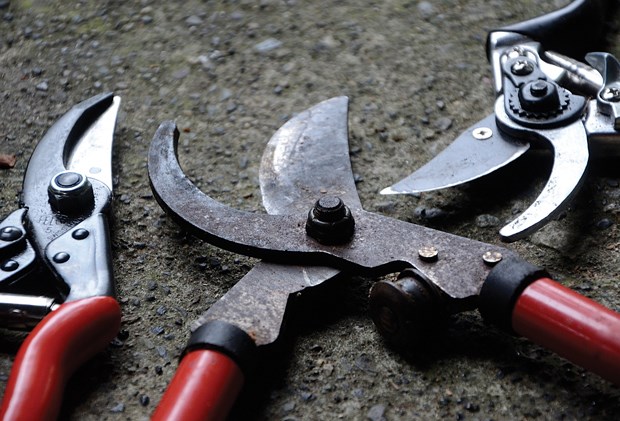With the advent of February, other gardening work must take a back seat to pruning, which must be completed before March arrives and the garden bursts into growth.
Contrary to popular habit, March is not the best time to prune many plants. Even though it may be easier for humans, it is not beneficial for many plants. February, however, affords us the opportunity to take advantage of plant dormancy to restructure many shrubs and vines.
Before I suggest some February pruning, let's go over the basics. Firstly, clean pruning tools to prevent the spread of disease from plant to plant as you cut. The old refrain, "I don't have time to clean my tools," is simply unacceptable if you care. Clean pruning tools also make cutting easier, which extends the length of time pruning can be done without fatigue or strain.
To clean my pruning tools to prevent disease transference and improve tool operation, I spray the anvil and both sides of the blade with Lysol disinfectant and then rub those surfaces with 200 or 300-grit sandpaper for metal, to sand off all plant sap residue. Once the tool's cutting surfaces are fully cleaned, I wipe off the residue and am ready to prune.
My cleaning process disinfects mechanically and chemically, and prevents disease from transferring during pruning. The process is reasonably benign to the environment, inexpensive and portable. Using bleach or rubbing alcohol to clean pruning tools is crude, poisonous and unnecessary.
Secondly, carpentry counts, meaning a proper pruning cut is made a quarter-inch above a bud or just outside of the branch collar, and at 90 degrees to the line of the branch to leave a square cut, not a sloped cut. Yes, I know there are sloped cutters and square cutters. It's a Ford or Chevy kinda thing. Square cuts are easier to make, leave less surface area to heal and less surface area for disease infestation. The old myth that water runs off the sloped cut more easily to prevent rot is just a myth. Sloped cuts are harder to make cleanly and they look ugly.
Thirdly, there are only two types of cuts in the known universe, a heading cut or a thinning cut. Heading cuts remove the end of the branch and induce bushiness. Thinning cuts remove a portion of the branch to a lower branch or the base of the plant, which results in a lowering of height or reduction of width and an increase of light penetration into the plant. Heading cuts are used to make plants bushier, for hedging or roses as an example, not for every plant that is too tall or too wide for its space. Thinning cuts are used to reduce height or width or to thin dense plants without drastically affecting natural form. Thinning cuts can also be used to invigorate basal regrowth on plants like forsythia, weigelia, shrubby dogwoods, hydrangeas, etc.
Thirdly, if you are pruning the same plant year after year to control size, perhaps that is the wrong plant in the wrong place. If you like hacking and shearing everything into balls or squares, who am I to tell you different, but those shapes are not restful to the human eye. Consider removal and replacement, or transplanting such plants to locations where they can grow to their mature size without onerous pruning. For smart gardeners, transplanting is a form of preventative pruning.
February is the time to prune hardy vines like wisteria, honeysuckle, grape, kiwi, some clematis that do not bloom in spring on last year's wood, and all other woody vines that bloom in summer or are grown for foliage display. The age of wood you prune is important for those vines because they bloom on wood that is two years old or older, not on new wood from last year. Retain old wood and prune back new shoots that originate from old wood.
For wisteria, kiwi and grape, prune all new growth back to a length that is equal to, or less than, the length of its attachment branch. Doing this provides for declining spur value,
meaning the length of secondary branch (spur), its old wood and new growth, measured from the main arterial branch attachment to the end of the secondary branch, will get shorter, not longer over time to produce an attractive and controlled branch formation (spur) where flowers and fruit will be borne.
Many deciduous and broadleaved trees, shrubs and vines can be pruned now with good results but remember to retain flowering wood, choose the proper type of cut and try to retain natural form. But most importantly pruning is not just a chore. Proper pruning requires skill to create something that is part science and part art.
Todd Major is a journeyman horticulturist, garden designer and builder, teacher and organic advocate. [email protected]



